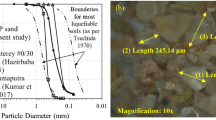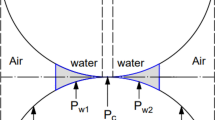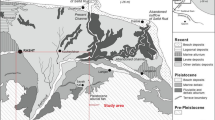Abstract
In this research, geotechnical properties and the relationship between cohesion (c) and internal friction angle (ϕ) with the SPT-N60 were investigated in 120 boreholes in the sedimentary basin of Kerman. Laboratory tests such as direct shear, triaxial, consolidation, and physical tests were carried out on soil samples extracted from the boreholes, and the SPT test was performed on all 120 boreholes. Since the soil in the area is CL, the SEM, XRD, XRF, physical, and mechanical properties of this soil were investigated. The artificial neural networks (ANN) and statistical analysis were used to estimate ϕ and c based on the SPT-N60. The petrography studies revealed that Quartz, Calcite, Dolomite, Albite, Illite, Clinochlore, and Microcline are the most plentiful minerals in this sedimentary basin. Also, the dominant clay is Illite. Illite clays, due to the low shear strength, have made some problems in the earth dams of the studied area. Results show that based on the SPT-N number, groundwater level, and soil texture the liquefaction hazard could not occur in this area. Previous equations are used to predict the c and ϕ and results are compared with this research. The obtained results from the ANN and statistical analysis showed that there is a good correlation between ϕ and c derived from the direct shear test with the SPT-N60. Based on R2, RMSE, P-value and Durbin-Watson statistics the correlation between c and the SPT-N60 is stronger than ϕ and the SPT-N60. Moreover, the ANN showed higher accuracy in predicting shear strength parameters compared to the simple regression.




















Similar content being viewed by others
Change history
25 August 2020
In the original publication of the article, the first author name was incorrectly published as “Benyamin Ghoreishii”. However, the correct name is “Benyamin Ghoreishi”. The original article has been corrected.
References
Abbaszadeh Shahri A (2016) Assessment and prediction of liquefaction potential using different artificial neural network nodels: a case study. Geotech Geol Eng 34:807–815
ASTM (2003) Standard test method for direct shear test of soils under consolidated drained conditions. Annual Book of ASTM Standards, ASTM D3080–03
ASTM (2004a) Standard test method for consolidated undrained triaxial compression test for cohesive soils. ASTM Int, West Conshohocken ASTM D4767–04
ASTM D (2004b) Standard Test Methods for one dimensional consolidation properties of soils using incremental loading ASTM D2435
ASTM (2005) Standard Test Method for Unconfined Compressive Strength of Cohesive Soil. In: Annual Book of American Society for Testing and Materials Standards, ASTM D2166.
ASTM (2007) Standard test method for particle-size analysis of soils. In: ASTM International, West Conshohocken. ASTM D421.
ASTM (2008) Standard test method for standard penetration test (SPT) and split barrel sampling of soils. Annual book of ASTM D1586
ASTM (2010) Standard test methods for liquid limit, plastic limit, and plasticity index of soils. In: The American Society for Testing and Materials, West Conshohocken, United States. ASTM D4318–10.
ASTM (2011a) ASTM D1586-11: standard test method for standard penetration test (SPT) and split-barrel sampling. ASTM International, West Conshohocken, pp 1–9
ASTM (2011b) Standard practice for classification of soils for engineering purposes (Unified Soil Classification System). In: American Society for Testing and Materials, Philadelphia. ASTM D2487–98.
ASTM (2014) Standard test methods for specific gravity of soil solids by water pycnometer. ASTM International, West Conshohocken. Annual Book of ASTM Standards, ASTMD854
Boadu FK (2018) Regression models to estimate critical porosity of soils from basic soil properties based on percolation theory. Geotech Geol Eng 36:1207–1216
Bagherzadeh Khalkhali A, Safarzadeh I, Rahimi Manbar H (2019) Investigating the effect of nanoclay additives on the geotechnical properties of clay and silt soil. J Mater Civil Eng 3(2):63–74
Erzin Y, Tuskan Y (2017) Prediction of standard penetration test (SPT) value in Izmir, Turkey using radial basis neural network. Celal Bayar Üniv fen bilim derg 13:433–439
Flood I, Kartam N (1994) Neural networks in civil engineering. I: Principles and understanding. J Comput Civ Eng 8:131–148
Foroutan M, Hassan MM, Desrosiers N, Rupnow T (2018) Evaluation of the reuse and recycling of drill cuttings in concrete applications. Constr Build Mater 164:400–409
Ghadimi H, Ebrahimian H (2015) MLP based islanding detection using histogram analysis for wind turbine distributed generation. UJRSET 3(3):16–26
Ghafoori M, Rastegarnia A, Lashkaripour GR (2018) Estimation of static parameters based on dynamical and physical properties in limestone rocks. J African Earth Sci 137:22–31
Ghorbani A, Jafarian Y, Maghsoudi MS (2012) Estimating shear wave velocity of soil deposits using polynomial neural networks: application to liquefaction. Comput Geosci 44:86–94
Hettiarachchi H, Brown T (2009) Use of SPT blow counts to estimate shear strength properties of soils: energy balance approach. J Geotech Geoenviron Eng 135:830–834
Jalili A, Firouz MH, Ghadimi N (2015) Firefly algorithm based on fuzzy mechanism for optimal congestion management. UJRSET 3(3):1–7
Javanmard M, Alamiparvin I, Farrokhi F (2018) Effect of valley slope on static and dynamic response of earth dams supported on rock foundation. UJRSET 6(01):24–34
Kashani H, Movahedi A, Morshedi MA (2019) An agent-based simulation model to evaluate the response to seismic retrofit promotion policies. Int J Disast Risk Re 33:181–195
Khaleghi Esfahani M, Kamani M, Ajalloeian R (2019) An investigation of the general relationships between abrasion resistance of aggregates and rock aggregate properties. Bull Eng Geol Environ 78:3959–3968
Kulhawy FH, Mayne PW (1990) Manual on estimating soil properties for foundation design (No. EPRI-EL-6800). Electric Power Research Inst., Palo Alto, CA (USA); Cornell Univ., Ithaca, NY (USA). Geotechnical Engineering Group
Lashkaripour GR, Rastegarnia A, Ghafoori M (2018) Assessment of brittleness and empirical correlations between physical and mechanical parameters of the Asmari limestone in Khersan 2 dam site, in southwest of Iran. J African Earth Sci 138:124–132
Lawson WD, Terrell EO, Surles JG, Moghaddam RB, Seo H, Jayawickrama PW (2018) Side-by-side correlation of texas cone penetration and standard penetration test blowcount values. Geotech Geol Eng 36:2769–2787
Mahmoud MAAN (2013) Reliability of using standard penetration test (SPT) in predicting properties of silty clay with sand soil. Int J Civ Struct Eng 3:545–556
Maier HR, Dandy GC (2000) Neural networks for the prediction and forecasting of water resources variables: a review of modelling issues and applications. Environ Model Softw 15:101–124
Meyerhof GG (1956) Penetration tests and bearing capacity of cohesionless soils. J Soil Mech Found Div 82:1–19
Moayed R, Janbaz M (2011) Subgrade reaction modulus of Tehran alluvium. Proc Inst Civ Eng Eng 164:283–288
Momeni E, Nazir R, Jahed Armaghani D, Maizir H (2014) Prediction of pile bearing capacity using a hybrid genetic algorithm-based ANN. Measurement 57:122–131
Montgomery DC, Peck EA, Vining GG (2012) Introduction to linear regression analysis. Wiley, New York
Mostafaei M, Rezaei Far AH, Rastegarnia A (2019) Assessment of the impact of case parameters affecting abrasion and brittleness factors in alluviums of line 2 of theTabriz subway. Iran Bull Eng Geol Environ 78(5):3851–3861
Motaharitabari S, Shooshpasha I (2018) Evaluation of coarse-grained mechanical properties using small direct shear test. J Geotech Eng, pp.1–13, https://doi.org/10.1080/19386362.2018.1505310
Muhunthan B (2000) Schofield. Liquifaction and dam failures, GeoDenver, Denver, Colorado
Mujtaba H, Farooq K, Sivakugan N, Das BM (2017) Evaluation of relative density and friction angle based on SPT-N values. KSCE J Civ Eng 22:572–585
Ocak I, Seker SE (2012) Estimation of elastic modulus of intact rocks by artificial neural network. Rock Mech Rock Eng 45:1047–1054
Ozer M, Isik NS, Orhan M (2008) Statistical and neural network assessment of the compression index of clay-bearing soils. Bull Eng Geol Environ 67:537–545
Peck RB, Hanson WE, Thornburn TH (1953) Techniques of subsurface investigation. Foundation Engineering.
Phoon K-K, Kulhawy FH (1999) Evaluation of geotechnical property variability. Can Geotech J 36:625–639
Rahimi E, Sharifi Teshnizi E, Rastegarnia A, Motamed Al-Shariati E (2019) Cement take estimation using neural networks and statistical analysis in Bakhtiari and Karun 4 dam sites, in south west of Iran. Bull Eng Geol Environ 78:1–18
Rastegar Nia A, Lashkaripour GR, Ghafoori M (2017) Prediction of grout take using rock mass properties. Bull Eng Geol Environ 76:1643–1654
Rastegarnia A, Sohrabibidar A, Bagheri V, Razifard M, Zolfaghari A (2017) Assessment of relationship between grouted values and calculated values in the Bazoft dam site. Geotech Geol Eng 35:1299–1310
Rastegarnia A, Teshnizi ES, Hosseini S, Shamsi H, Etemadifar M (2018) Estimation of punch strength index and static properties of sedimentary rocks using neural networks in south west of Iran. Measurement 128:464–478
Rastegarnia A, Lashkaripour GR, Ghafoori M, Farrokhad SS (2019) Assessment of the engineering geological characteristics of the Bazoft dam site. QJEGH 52:360–374
Robertson PK, Fear CE (1996) Soil liquefaction and its evaluation based on SPT and CPT. In: Proceedings of NCEER Workshop on Evaluation of Liquefaction Resistance
Saghi H, Behdani M, Saghi R, Ghaffari AR, Hirdaris S (2019) Application of gene expression programming model to present a new model for bond strength of fiber reinforced polymer and concrete J Mater Civil Eng 3(1):15–29
Sanaei F, Kazemi MAA, Ahmadi H (2015) Designing and implementing fuzzy expert system for diagnosis of psoriasis. UJRSET 3(02):41–49
Seyfi R (2017) Application of artificial neural network in modeling separation of microalgae. UJRSET 5(04):43–49
Shahrokhabadi S, Vahedifard F, Ghazanfari E, Foroutan M (2019) Earth pressure profiles in unsaturated soils under transient flow. Eng Geol 260:105218
Shamsashtiany R, Ameri M (2018) Road accidents prediction with multilayer perceptron MLP modelling case study: roads of Qazvin, Zanjan and Hamadan. J Mater Civil Eng 2(4):181–192
Sivrikaya O, Tougrol E (2006) Determination of undrained strength of fine-grained soils by means of SPT and its application in Turkey. Eng Geol 86:52–69
Sivrikaya O, Kayadelen C, Cecen E (2013) Prediction of the compaction parameters for coarse-grained soils with fines content by MLR and GEP. Acta Geotech Slov 10:29–41
Sohrabi-Bidar A, Rastegar-Nia A, Zolfaghari A (2016) Estimation of the grout take using empirical relationships (case study: Bakhtiari dam site). Bull Eng Geol Environ 75:425–438
Venkatasubramanian C, Dhinakaran G (2011) ANN model for predicting CBR from index properties of soils. Int J Civ Struct Eng 2:605–611
Wang J, Guo J, Bai J, Wu X (2018) Shear strength of sandstone–mudstone particle mixture from direct shear test. Environ Earth Sci 77:442
Wolff TF (1989) Pile capacity prediction using parameter functions. In: Predicted and observed axial behavior of piles: results of a pile prediction symposium, pp 96–106
Yagiz S, Akyol E, Sen G (2008) Relationship between the standard penetration test and the pressuremeter test on sandy silty clays: a case study from Denizli. Bull Eng Geol Environ 67:405–410
Zorlu K, Gokceoglu C, Ocakoglu F, Nefeslioglu HA, Acikalin S (2008) Prediction of uniaxial compressive strength of sandstones using petrography-based models. Eng Geol 96:141–158
Author information
Authors and Affiliations
Corresponding author
Additional information
Publisher's Note
Springer Nature remains neutral with regard to jurisdictional claims in published maps and institutional affiliations.
The original version of the article was corrected due to change in first author name
Rights and permissions
About this article
Cite this article
Ghoreishi, B., Khaleghi Esfahani, M., Alizadeh Lushabi, N. et al. Assessment of Geotechnical Properties and Determination of Shear Strength Parameters. Geotech Geol Eng 39, 461–478 (2021). https://doi.org/10.1007/s10706-020-01504-1
Received:
Accepted:
Published:
Issue Date:
DOI: https://doi.org/10.1007/s10706-020-01504-1




